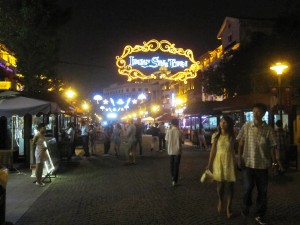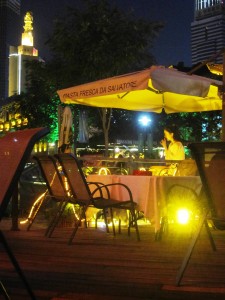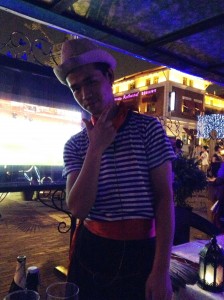 It isn’t really the sort of thing one expects to see in a sprawling, congested city just south of Beijing, China: a pocket of (albeit slightly confused) western Europe, complete with cobblestone streets, kegs of dark beer, Roman fountains and alfresco dining — with red checkered table cloths of course!
It isn’t really the sort of thing one expects to see in a sprawling, congested city just south of Beijing, China: a pocket of (albeit slightly confused) western Europe, complete with cobblestone streets, kegs of dark beer, Roman fountains and alfresco dining — with red checkered table cloths of course!
Dubbed Italian-Style Town, this tourist draw in Tianjin is a sight to behold.
Even though the area is undeniably kitschy, it is great fun to spend a golden-lit evening dining on pasta next to a bronze statue of Marco Polo, while listening to a determined Chinese jazz singer roll out velvet songs against the oompah-oompah of “Paulener” house’s German blasts just thirty feet away.

And all around, tourists mill the “Italian” kiosks selling everything from Venetian masks (which sell for less than the one I actually bought in Venice back in 2005) to gelato (tried a chocolate scoop and it was pretty good!) to little wooden Pinocchio’s.

Built in the early 1900’s as part of the Italian concession in Tianjin, this area was re-vamped in the mid 2000’s to make it what you see today: a Disney-esque rendition of Italy, Bavaria Germany and a little bit of France, all rolled into one. Italian Town centers around Marco Polo Square, where double-decker tourist buses, horse-drawn carriages and taxis troll the circular drive amidst the flash of cameras. From here, Italian Style Town is said to be laid out like a chess board, filling the smallish, pedestrian-only space with Chinese celebrity mansions, little souvenir shops, bars, cafes and restaurants. While most of these restaurants appear to be Bavarian in nature, their menus often feature more local tastes such as Chinese dishes, fried chicken fingers and the like. But they do have German beer.

There is at least one authentic Italian restaurant in Italian town: Cafe Venezia (a/k/a “Venezia Club”), which is quite good but rather crowded. A Singapore-based Italian restaurant chain, Pasta Fresca, is one street over, far less packed and I think, a little less expensive, too. But anywhere you stop to eat in Italian-Style Town will have the tourist prices to match, probably on par with most 4 or 5 star hotel restaurants in town.
Once you’ve stuffed your face and meandered over the cobblestones to your satisfaction, the river walk just outside is a great place to take in Tiajin’s nightlife. Here, you will stroll passed groups of women doing their slow, exercise-dancing (not Tai Chi — this is something else entirely), outdoor karaoke stands, vendors selling snuff-pots and cultural revolution wares and more. During the day and early evening, this area, and the golden bridge arching of the Haihe River, is an extremely popular wedding photo spot as well. At any given time, you will most likely catch at least two brides-to-be modeling gorgeous gowns against the backdrop of Italian concession buildings and golden statues.

Getting There:
Taxi. Taxis are cheap and everywhere, so hailing one to Italian Style town might be your best bet.
Bus. If you want to take the bus (recommended, for the experience alone) you have many options. Just remember that most lines stop early-ish at night, as in anywhere from 7:30 to 9:30. Very few buses go past 10 pm.
The following buses stop at Bo’hai Road (“Bo’hai Dao’), which the southern-most road at the edge of Italian Town: 5, 635, 639, 672, 676, 680, 805, 806, 806, 836, 901, 905, K832 and 6.
These buses stop at Haihe East Road (“Haihe Dong Dao”) which turns into Jinbu Dao, the northern-most road at the edge of Italian Town:
View Larger Map
Helpful Hint: In planning your route, use Google Chrome to locate your destination. Normally, Chrome translates everything to English for you, which you will find quite helpful when facing a map full of Chinese characters!



2 thoughts on “Tianjin’s Italian-Style Town”